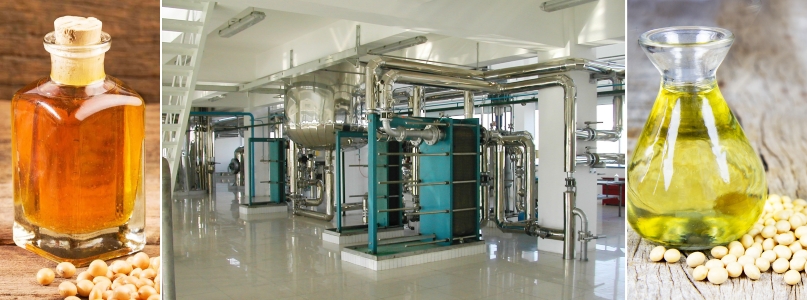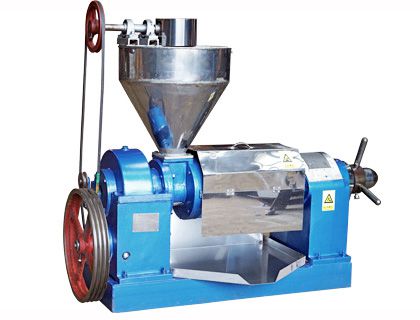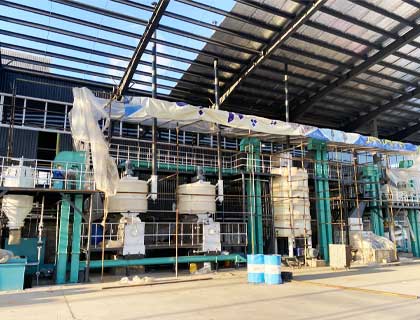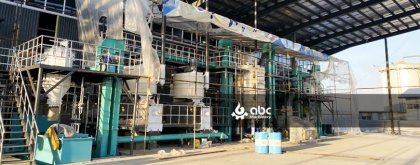
Soybean Oil Extraction Process Overview
From Raw Material to Pre-Treatment: The Starting Point of Efficient Soybean Oil Extraction
The soybean oil extraction process begins long before the actual solvent extraction phase. High-quality production depends on precise control of raw material and pre-treatment stages. Selecting soybeans with moisture content between 10–12% and oil content of at least 18% is essential for consistent performance in industrial-scale soybean oil extraction.
During cleaning, mechanical sieves and magnetic separators remove impurities, achieving up to 99.5% cleaning efficiency. Cracking reduces soybean particle size to around 0.3 mm, improving surface area for solvent penetration. Softening follows at 65–70°C, adjusting moisture for better flake formation. The flaking process produces sheets 0.25–0.35 mm thick, which enhances cell rupture and maximizes solvent access.
Pre-treatment directly impacts oil yield. Studies show that optimized flake thickness can improve yield by up to 2.5%, while poorly prepared material can reduce extraction efficiency by 4–5%. Consistent monitoring of particle size, temperature, and moisture ensures higher throughput and stable oil recovery.

Soybean Cleaning, Crusher, Extruder Machine Before Oil Extraction
Soybean Oil Solvent Extraction Optimization for Higher Yield and Safer Production
Solvent Selection and Process Principles
The solvent extraction phase defines the core efficiency of any soybean oil extraction process. Industrial operations often rely on n-hexane as the primary solvent because of its strong oil solubility, low boiling point (69°C), and easy recovery. Alternative solvents such as isopropanol or ethanol are being evaluated for sustainability, but n-hexane remains the most cost-effective at scale, reducing per-ton extraction costs by 10–15% compared to alternatives.
Extraction Equipment Design and Plant Throughput
Modern solvent extraction equipment design focuses on energy efficiency and safety. Continuous extractors (such as Rotocel or Loop types) maintain a solvent-to-solid ratio of 0.7–0.9:1, ensuring over 98% oil recovery. Plant capacities typically range from 200 to 1,000 tons per day, depending on the extractor configuration and desolventizing system.
| Extraction System | Typical Capacity (TPD) | Oil Recovery Rate (%) | Solvent Loss (kg/ton) |
|---|---|---|---|
| Rotocel Extractor | 200–600 | 97.5–98.2 | 1.2–1.5 |
| Loop Extractor | 400–1,000 | 98.0–98.5 | 1.0–1.2 |
The desolventizer-toaster (DT) operates at 105–110°C and below 0.3 bar, efficiently removing residual solvent and preserving protein quality in soybean meal. Energy integration between extractor vapor and DT system can lower steam consumption by 15–18%.
Process Optimization and Monitoring
- Solvent Circulation Control: Optimizes solvent-to-solid ratio for reduced consumption.
- Heat Integration: Reuses condensation heat for preheating, saving up to 30 kWh/ton.
- Automated Recovery: Minimizes hexane losses via condenser and vacuum stripper design.
- Emission Reduction: Ensures VOC emissions below 20 mg/m³ through efficient recovery.
- Predictive Maintenance: Uses vibration analysis to detect extractor bearing wear before failure.
Proper balancing between energy input and solvent flow leads to consistent oil quality and plant reliability.

Rotary Solvent Extractor
Design a safer, higher-yield solvent extraction plant with our process engineers — optimize your extraction efficiency today.
Desolventizing and Refining: From Crude Soybean Oil to High-Purity Product
Once crude soybean oil is separated, it passes through desolventizing and refining stages. Desolventizing removes residual hexane under vacuum at 105°C, achieving solvent levels below 300 ppm in the meal. The refined oil then undergoes degumming (removal of phospholipids), neutralization (acid removal), bleaching (color reduction), and deodorization (odor elimination).
The soybean oil refining process enhances oil stability and flavor. Bleaching earth dosage typically ranges from 0.8–1.2%, while deodorization operates at 230–250°C for 1.5–2 hours. These steps produce refined oil meeting international edible standards with less than 0.05% free fatty acid (FFA) content and transparency >95%.
Automated inline spectrometers using Near-Infrared Reflectance (NIR) monitor color and FFA levels, ensuring consistent output. The final stage includes quality testing according to ISO 660 and AOCS standards.

Large Continuous Soybean Oil Refinery Plant
Ensure high-purity, food-grade refined soybean oil with our automated refining system design — contact our team for plant-specific engineering guidance.
Plant Design and Integration for Efficient Production
Efficient factory operation requires more than just good extraction equipment. Smart soybean oil extraction plant design integrates energy, automation, and safety systems for continuous, high-throughput production. Layout optimization can reduce material handling time by 15–20% and save up to 40 kWh/ton in total energy consumption.
The integration of Supervisory Control and Data Acquisition (SCADA) and MES ensures end-to-end visibility, while modular plant design enables phased capacity expansion. Engineering, Procurement, and Construction (EPC) models streamline delivery, typically cutting construction lead times by 25%.
Effective integration between extraction, refining, and packaging units allows smooth data flow and real-time performance tracking.
Strategic cost control through modular construction and standardized equipment selection improves ROI across multi-line operations. Centralized control rooms enhance operator safety and minimize human error.
Get your customized soybean oil extraction EPC project proposal — partner with us to engineer a high-efficiency production line that drives consistent profitability.
The soybean oil extraction process integrates material science, thermodynamics, and plant engineering to achieve consistent yield, safety, and cost-efficiency. From pre-treatment to refining, each stage contributes to the overall success of modern soybean oil extraction operations worldwide.
We receive enquiries in English, Español (Spanish), Русский язык (Russian), Français (French) and العربية (Arabic).Our professional team will reply to you within one business day.Please feel free to contact us!


 Screw Oil Press
Screw Oil Press Small Oil Mill Plant
Small Oil Mill Plant Small Oil Refinery
Small Oil Refinery Automatic Oil Press
Automatic Oil Press Multifunction Oil Press
Multifunction Oil Press Hydraulic Oil Press
Hydraulic Oil Press


![[Presidential Visit] Zimbabwe 30 Tons/Day soybean oil plant for Extraction and Refinery Was Successfully Completed](/uploads/allimg/soybean-oil-plant-press-refine-business-lp.jpg)

